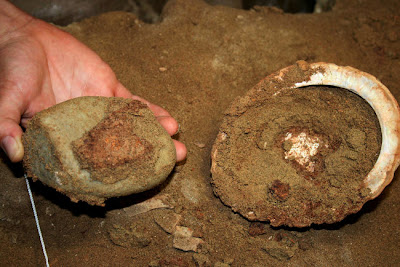 Until recently the oldest evidence of art was about 60,000 years old, and seemed to coincide with a general increase in the complexity of human societies: larger settlements, more complex shelters, growing populations. Some archaeologists took this data so seriously that they imagined a "Paleolithic Revolution" focused on the invention of symbolic behavior. One theory even had it that the underlying event must have been the invention of language.
Until recently the oldest evidence of art was about 60,000 years old, and seemed to coincide with a general increase in the complexity of human societies: larger settlements, more complex shelters, growing populations. Some archaeologists took this data so seriously that they imagined a "Paleolithic Revolution" focused on the invention of symbolic behavior. One theory even had it that the underlying event must have been the invention of language.I never took these ideas seriously. The first dates of such things keep being pushed backward by new research, so I figured the 60,000 barrier would be crossed eventually, and I think that language is so fundamental to human nature that it must have existed in its full form among the very first humans.
Now there is really good evidence of "symbolic behavior" around 100,000 years ago, in the form of a small workshop for making "paint" from ocher:
Digging deeper in a South African cave that had already yielded surprises from the Middle Stone Age, archaeologists have uncovered a 100,000-year-old workshop holding the tools and ingredients with which early modern humans apparently mixed some of the first known paint. These cave artisans had stones for pounding and grinding colorful dirt enriched with a kind of iron oxide to a powder, known as ocher. This was blended with the binding fat of mammal-bone marrow and a dash of charcoal. Traces of ocher were left on the tools, and samples of the reddish compound were collected in large abalone shells, where the paint was liquefied, stirred and scooped out with a bone spatula.
 Ocher seems to have fascinated people partly because it is sort of reddish brown in its natural form but turns blood red when you put it in a fire. We know that some modern stone-age people think of red ocher as a symbol of blood and hence life, and this association seems to be very ancient.
Ocher seems to have fascinated people partly because it is sort of reddish brown in its natural form but turns blood red when you put it in a fire. We know that some modern stone-age people think of red ocher as a symbol of blood and hence life, and this association seems to be very ancient.Note that the caves where the paint-mixing gear was found don't containing any paintings on the walls. Might just be because the traces have disappeared, but it might be because, as many have speculated, the first human art was painting on our own bodies.


No comments:
Post a Comment